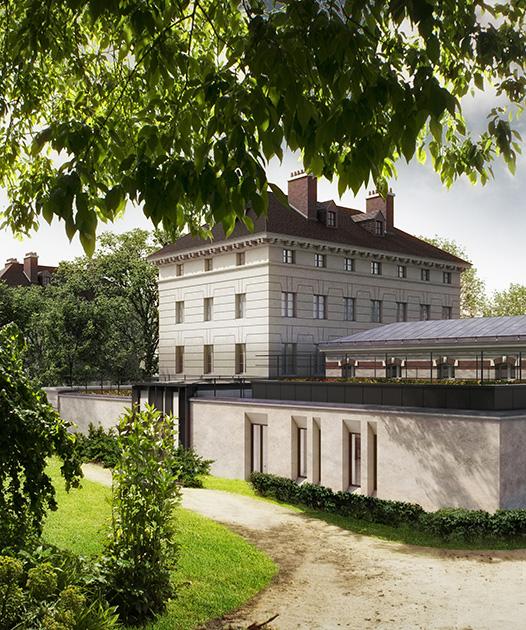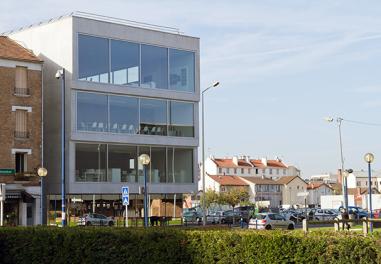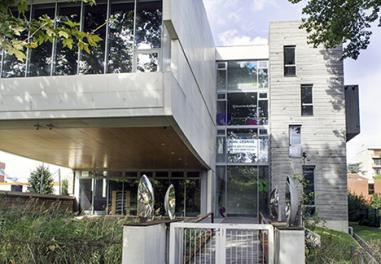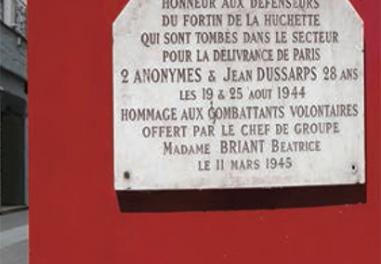The Liberation of Paris: the backdrop for a new museum
On 25 August 2019, Paris celebrates the 75th anniversary of its liberation. For the Musée de la Libération de Paris – Musée du Général Leclerc – Musée Jean Moulin, due to be officially opened that day at Place Denfert-Rochereau, a new page of its history, begun 25 years ago, is being written.

To mark the 50th anniversary of the Liberation of Paris, the Jean Moulin Museum and the Memorial to General Leclerc de Hauteclocque and the Liberation of Paris were opened in the Jardin Atlantique, above Paris-Montparnasse railway station. In 2015, the Mayor of
Paris decided officially to transfer the museum to a new, more visible and more easily accessible site. The project was undertaken by public establishment Paris Musées and Paris City Council’s department for building, heritage and architecture.
In the footsteps of the Liberation of Paris
Why choose the tollhouses built by architect Claude Nicolas Ledoux in the late 18th century? These two buildings have, on the face of it, little to do with the Second World War. They were originally used to house the taxation service, then later the city council quarries inspectorate and material testing laboratory were installed here, as well as the entrance to the Catacombs, which attract hordes of visitors.
The interest in transferring the Musée de la Libération de Paris – Musée du Général Leclerc – Musée Jean Moulin to Denfert-Rochereau lies in the basement. Beneath the buildings, which lie on the path taken by on 25 August 1944, is a defensive shelter. This disused shelter served as the headquarters of the FFI for the Paris region, from 20 to 28 August 1944. The idea of offering both a permanent exhibition and a site visit was a must. The layout therefore included the discovery of Colonel Rol-Tanguy’s former command post, 20 metres below ground.
An architectural project combining heritage and modernity
The Barrière d’Enfer tollhouses are listed historic monuments. They form part of the city of Paris’s rich built heritage. Architecture firm Artène (Christophe Batard ACMH) oversaw the renovation work on the two buildings on either side of Avenue du Colonel Rol-Tanguy. All of the museum’s features were able to be accommodated: permanent and temporary exhibition spaces, reserves, learning room, documentation centre, reception areas and conference room. It was decided to make a permanent visitor trail on two levels, beginning on the ground floor of the left-hand tollhouse and continuing in the adjoining building. This enabled a visit to be created in which large, bright modern spaces contrast with smaller rooms. The exhibition layout is able to make use of these new areas to tell the story.
An encounter between history and the public
People's knowledge and expectations have changed considerably since the creation of the Montparnasse museums, 25 years ago: today, the Second World War is more remote in time, no longer so easily understood, and the generation who preserved its memory are no longer with us. Visitors no longer have the same keys to unlock this history. Their demands in terms of visitor experience have changed, and outreach tools mean a wider variety of approaches are available. Meanwhile, the new location opposite the Catacombs attracts foreign tourists with little knowledge of French history. Taking these new circumstances into account, the purpose and aims of the museum display were set out in advance: a clear, informative presentation, backed up by scientific explanations, to give the general public – the central focus – an understanding of the historical issues.
The choice of the permanent exhibition
Therefore, a new display for a new audience at a new site had to be put together from the museum’s private collections. To begin with, a bequest from Jean Moulin’s friend, Antoinette Sasse, provided the museum with archives on the "Unifier of the Resistance". These were added to by donations, bequests and purchases from the Moulin family. Next, a donation from the Fondation Maréchal Leclerc de Hauteclocque contributed objects that belonged to General Leclerc and to the men and women of the 2nd Armoured Division. Finally, the museum expanded its collections considerably by gathering first-hand testimonies and acquiring books, documents and photographs of soldiers, the Resistance and the Liberation of Paris, under Christine Levisse-Touzé’s directorship of the museum, from its founding until 2017.
The museum has a scientific committee, which assisted with devising a display that was attuned to the personality and actions of Jean Moulin and Philippe de Hauteclocque, the future General Leclerc. Photos, correspondence and objects shed light on their journey and struggle. The Second World War, occupied Paris, the fighting of the Resistance, military combat and the liberation of Paris are all evoked through the stories of the two great figures, as well as those of ordinary men and women – members of the Resistance, Parisians, soldiers. The design of the layout (agency Klapisch-Claisse) plays on space, using the more cramped areas to present the Resistance and repression and the more spacious areas to portray the theme of the liberation of Paris. The public is brought face to face with the works, so that fragile documents and everyday objects tell the stories of the lives and involvement of individuals, in some cases until death. We hope to offer visitors an insight into these events, inspiring them to want to understand what was at stake at this precise moment in French history, and to think about the issues involved, which resonate so profoundly today.
The Parisian setting
The museum is located in a particularly dense cultural setting. The existing museums – Musée de la Résistance Nationale, Mémorial de la Shoah, Musée de l’Ordre de la Libération, Musée de l’Armée – offer displays of major interest on the theme of the Second World War. Heir to the Montparnasse museum, the Musée de la Libération de Paris – Musée du Général Leclerc – Musée Jean Moulin already has its place among these partners, with which it interacts. Its role is to plunge visitors into a world at war, explain the values defended by Moulin, Leclerc, the Resistance in the shadows and the troops in the limelight, and encourage people to think about these decisive events. An ambitious goal, which we hope will win over the public.
Read more
Address: 4, Avenue du Général Rol-Tanguy
Place Denfert-Rochereau, Paris 14e
www.museesleclercmoulin.paris.fr
Lieux de mémoire
Musée de la Libération de Paris - Musée du Général Leclerc - Musée Jean Moulin
musée de la Résistance nationale
musée de l’Ordre de la Libération
Mémorial Jean Moulin de Caluire
Personnalités
Articles of the review
-
The file

Remembrance tourism in Île-de-France
>In Île-de-France, remembrance tourism is a sector undergoing considerable change. Building on the First and Second World War commemorative cycles, the region has seen, on the initiative of actors like the Ministry of the Armed Forces, the gradual integration of its remembrance sites and cultural...Read more -
The figure

The MRN: a museum for tomorrow
A completely redesigned Musée de la Résistance Nationale (MRN) is preparing to open at Champigny-sur-Marne, with exhibition spaces housed in a new building and a research centre on the historical site. An ambitious project offering a fresh insight into the Resistance.
Read more -
The interview

Philippe Apeloig
Graphic designer and typographer Philippe Apeloig has compiled a large-format book of photographs of all of Paris’s Second World War commemorative plaques. Combining typography and remembrance, the plaques reveal the whole tragic story of the period.
Read more

